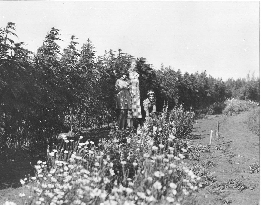Growing Cannabis Hemp in Canada: A Resource Guide
Cannabis hemp is useful.
From clothing to paper, car parts to housing, it is versatile, renewable and earth-friendly. Law changes have entitled Canadians to grow Cannabis hemp commercially in 1998 & 1999. This document contains information on hemp in Canada, and includes contacts for further information. & permits
Looking back
In the 1920’s, Cannabis hemp was used as the base in oils and varnishes, it made a durable woven cloth, rot-resistant ropes and sails, seed food & oil, paper material, and a medicinal remedy among other uses.
The annual crop was grown for any number of its uses by many people, worldwide. It grew well in many areas, including Alberta.
Cannabis hemp was banned in Canada on the strength of a racist anti-marijuana campaign.
Not many Canadians had even heard of marijuana when it was banned, but in 1928, farmers were surprised to discover that they could not grow their useful hemp crops any longer – by law. This law was upheld across the nation, farmers’ crops would be uprooted if they did not comply.
Follow the money
With cannabis hemp gone, the world of fossil fuels, plastics, pharmaceutical drugs and pulping and bleaching tree paper began. Cotton and synthetic materials took over fashion.
Except for brief stints during wartime, hemp farmers were out.
Owners of forest land, chemical patents, oil extraction, pharmaceutical patents and herbicide/pesticide companies were in.
The Hempire Strikes Back
Jack Herer published “The Emperor Wears No Clothes” in 1985. This book was a study of man & cannabis. In documented, cross-referenced and footnoted detail, it stated that no-one had ever died from smoking cannabis, and that there were tens of thousands of products that could be made from the same useful hemp plant. This book re-jump-started hemp industry and cannabis activism.
In Canada
In May of 1998, Canadian law changes changed to allow a “test period” of growing commercial hemp, re-evaluated by Health Canada in 2000.
Making money, making hemp.
Because it has been prohibited for so long, growing hemp isn’t “easy money”. The need for proper seeding and harvesting equipment, textile and pulp processing mills, seed pressers, these are all challenges facing Canada’s hemp industry. Additionally, the laws could change in 2000 when Health Canada evaluates hemp laws.
Of the 200 Canadian farmers who grew hemp in 1998, about 70% of them opted to grow hemp grain, or seed.
Hemp seed oil contains Essential Fatty Acids and Amino Acids in an uncommon ratio very good for humans’ digestion and skin. Hemp seeds are eaten by a number of people in Canada. They are good tasting and are good for you. They can be roasted, boiled, mashed, or seasoned.
Hemp seed oil is used in baking, cooking and salad oils.
A flax seed press can be used to press hemp seeds. Keeping the oil away from light, heat and oxygen is important to quality and nutritional content.
Manitoba industry is pressing hemp seed oil for retail sale.
To date, there is no textile mill in Canada for turning raw hemp into fabric, twine or rope.
Hemp as a biomass fuel has excellent potential. A renewable, high energy-producing crop, hemp fuel can burn clean, but is still a research area.
Paper mills require conversions to switch to non-tree pulps. None of the big mills have considered this, but a group of investors in BC want to convert an old tree paper mill into a hemp paper mill.
Current “hemptrepreneurs” are looking at a 3 to 5 year cost recovery timeframe.
Money into the economy without the toxic runoff!

Hemp as a windbreak, on a farm near Warwick AB. 1920
Photo from the Alberta Provincial Archives.
Growing hemp requires a permit in Canada. To apply for a license, contact Health Canada.
The application package is available from
Health Canada: Jean Peart
Manager, Hemp project
Bureau of Drug Surveillance
Therapeutic Products Directorate
Health Protection Branch
122 Bank Street, 3rd floor
Ottawa, On
K1A1B9
Website – www.hc-sc.gc.ca/hpb-dgps/therapeut/htmleng/hemp.html
Book resources include:
Hemptech’s “Cultivation of Hemp “
Hayo Van derWerf’s “Crop Physiology of fibre hemp”
Jack Herer’s “The Emperor Wears No Clothes”
John W. Roulac “Hemp Horizons”
All these books are available at True North Hemp Company
Don't Smoke The Hemp!!!!
Although cannabis flowers have over 3000 chemicals in them, it is generally accepted that the psychoactive ingredient is Tetrahydracannibinol (THC). THC is also part of the pest-resistance arsenal of Cannabis hemp.
Canadian parliament arbitrarily decided that a 0.03% THC level was the limit for industrial hemp. In contrast, cannabis flowers for smoking will have THC levels between 9-30%
In tested Alberta hemp crops, THC levels were as low as 0.00009% . It would take more than four football fields full of hemp to produce enough THC to get one person high!!
If you see a field of hemp, don’t trespass on private property, admire it from outside the fence, and don’t pick it. It can’t get you high, but it can get you in serious trouble with a farmer or a Mountie.
Copyright © True North Hemp Company Ltd.
All rights reserved. Any trademarks remain the property of their respective holders.
webmaster@cannabisland.com